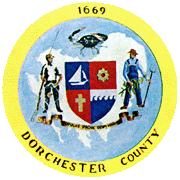
Dorchester County’s legal origin is not known, although there is evidence the County was in de facto existence by 1668 from a writ which was issued to the County Sheriff by the Lord Proprietary. The County was named for Sir Edward Sackville, the 4th Earl of Dorset, England, who was a friend of the Calvert family that founded Maryland. The Earl had previously assisted in the administration of the Virginia settlement of Jamestown in 1631. Dorset, as Dorchester County was originally called, was a political entity by 1669.
Just where the first Court of Justices met in 1669 or 1670 is unknown. However, private family papers show that court sessions were held in a town site called “Islington,” on “Nicholas Mayney’s Point” or “John’s Point,” on the Little Choptank River alongside Brook’s Creek in present day Woolford. Thereafter, the Court was removed to “Harwood’s Choice,” a plantation lying on the most easterly branch of Fishing Creek, a tributary of the Little Choptank River. At a session of the Court held December 11, 1673, William Worgin gave 25 acres of Harwood’s Choice and “a new house lately built and finished by George Seward for the keeping of the courthouse there.” William Worgin also gave timber for the buildings and firewood for the use of the Court. Court was held there until established in Cambridge in 1687.
The second courthouse in Dorchester County was the first courthouse built in Cambridge and was constructed by Captain Anthony Dawson in 1687. Captain Dawson contracted with Major Thomas Taylor to build a courthouse for the consideration of 26,000 pounds of tobacco (worth about $1,300 in the day). That courthouse was in use until taken down and sold in 1770 when the second courthouse in Cambridge was built pursuant to an act of the Assembly passed in the year 1770. The act directed that 200,000 pounds of tobacco would be assessed to be paid to Charles Dickinson, William Ennals, Robert Harrison and John Goldsborough, Jr. who were to meet in Cambridge by March 15th and contract with workmen to build the new courthouse. That courthouse was built of brick upon the site where the present courthouse now stands, a few feet closer to the street from where it now stands. The courthouse was destroyed by fire, supposedly arson, in 1851. The records of the clerk’s office were saved, but all of the records in the register’s office were burned.
The original portion of the present courthouse was completed and occupied in 1853 at a cost of $18,162.31. It is the only courthouse designed by the respected Maryland architect, Richard Upjohn.
The courthouse was Italianate influenced and constructed of brick which was painted. The courthouse was extensively remodeled with Georgian Revival decorative detailing in the 1930’s. The façade of the present courthouse is divided into three nearly equal parts, each being entirely different. The central division contains the main entrance to the building and is flanked on the north by a three story tower and on the west by an identical block, only two stories in height. Supporting the large structure is a granite foundation made of enormous slabs with a chamfered water table course above. Three Romanesque arches in the central section of the building contain double doors with semi-circular wood panels above bearing a large recessed circle with flanking triangular recesses. Large quoins ornament the corners of the building and towers and three stringcourses divide the building vertically while providing continuity horizontally. All windows on the front façade in the second floor are round arched large sash windows. A modillion cornice ornaments the overhanging eaves of the hip roof. A low-lying open space to the southwest known as Spring Valley, has a cast iron fountain as its focal point. In 1995 the size of the courthouse doubled when an addition with similar architectural characteristics was built. The courthouse was listed on the U.S. National Register of Historic Places in 1982 and was named by the National Park Services as an official site of the Underground Railroad Network to Freedom in 2005.

